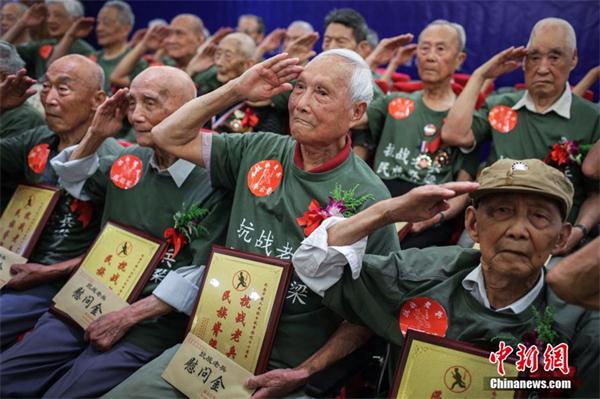Commemorate joint contributions of KMT and CPC
- By Wang Jianlang
 0 Comment(s)
0 Comment(s) Print
Print E-mail China Daily, July 8, 2015
E-mail China Daily, July 8, 2015
|
|
|
A total of 33 veterans meet to mark the 78th anniversary of the beginning of the War of Resistance against Japanese Aggression in July 7, 1937, in Nanjing, Jiangsu, July 5, 2015. [Photo/chinanews.com] |
The Marco Polo Bridge Incident, or the July 7 Incident in 1937, marks Japan’s full-scale invasion of China and the start of the Chinese People’s War of Resistance against Japanese Aggression (1937-1945). The ultimate victory was won by all Chinese people, and should be jointly commemorated on both sides of the Straits after seven decades.
However, it is noteworthy that some are trying to defame the fight behind enemy lines that was led by the Communist Party of China; showing little respect to the wartime history and an unnecessary obsession with the number of battlefield casualties. Similar unwise voices can also be heard in Taiwan, where a few are sought to discourage Kuomintang veterans from attending the commemorative parade on Sept 3 in Beijing, for the sake of their “health”.
The hard-won triumph of the Chinese People’s War of Resistance Against Japanese Aggression was the first overall victory against outside invasion in China’s modern history. The anti-Japanese united national front based on cooperation between the then ruling KMT and the CPC, played a central role in winning the struggle.
After the Marco Polo Bridge Incident, it was the CPC that pushed hard for cooperation with the KMT to fight the Japanese troops, despite their decade-long civil war. The victory in 1945 belongs to the entire Chinese people, regardless of their party, and arguing over the contributions made by the CPC and KMT during that period does nothing to help the present situation.
Disconnecting the two battlefields and separating their historical contributions may be an attempt to worsen the current ties between the CPC and the KMT, and generate tensions across the Straits. However, the truth is, the frontline battles and the ones behind enemy lines were interdependent, and the two forces supported each other throughout the eight-year war.
True, the KMT-led army as the country’s major military force was sent to engage the Japanese in the frontline, yet they failed to resist the ferocious attacks launched by Japanese troops, who later occupied large swathes of Chinese soil. The CPC guerrillas, however, infiltrated behind enemy lines and established a number of bases that effectively prevented the full might of the Japanese from being deployed against the KMT forces: Over half of the Japanese forces and almost all the troops of the puppet “Manchurian State” established by the Japanese in Northeast China, were engaged with fighting the CPC.







Go to Forum >>0 Comment(s)